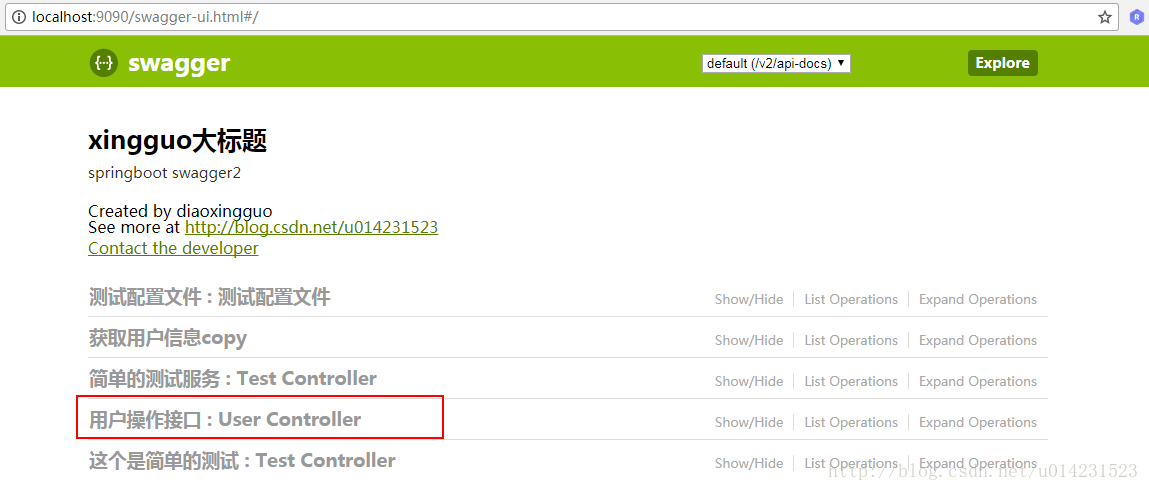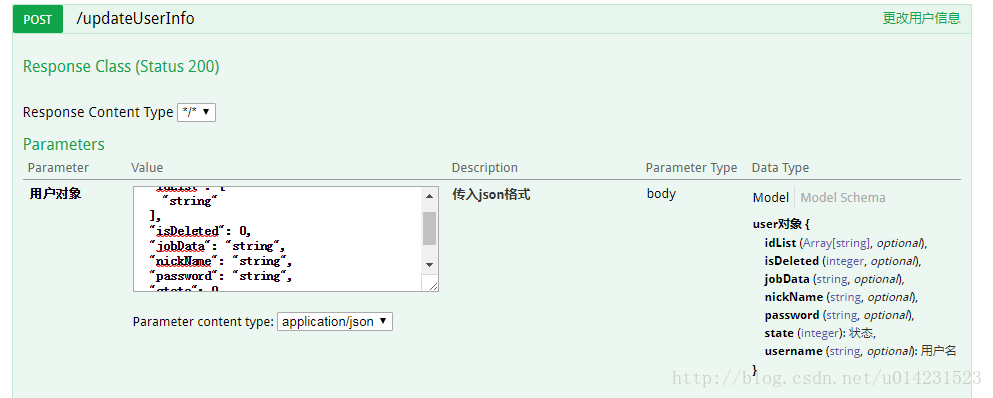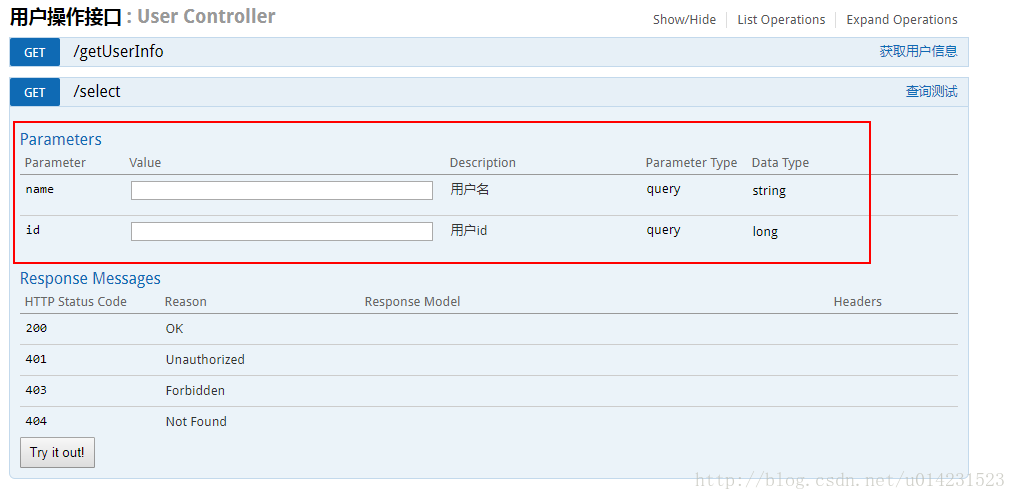Swagger是一个规范和完整的框架,用于生成、描述、调用和可视化 RESTful 风格的 Web 服务。总体目标是使客户端和文件系统作为服务器以同样的速度来更新。文件的方法,参数和模型紧密集成到服务器端的代码,允许API来始终保持同步。
Pom依赖
在pom.xml文件中添加swagger相关依赖
<!-- Swagger依赖包 --> <dependency> <groupId>io.springfox</groupId> <artifactId>springfox-swagger2</artifactId> <version>2.2.2</version> </dependency> <!-- Swagger的ui界面 --> <dependency> <groupId>io.springfox</groupId> <artifactId>springfox-swagger-ui</artifactId> <version>2.2.2</version> </dependency>
配置Swagger
新建Swagger配置类,需要特别注意的是Swagger scan base package,这是扫描注解的配置,即你的API接口位置,对前端提供服务接口的位置。
package com.example.demo.config; @Configuration @EnableSwagger2 public class SwaggerConfig { private ApiInfo apiInfo() { return new ApiInfoBuilder().title("API接口文档") .description("用户信息管理") .version("1.0.0") .build(); } @Bean public Docket createRestApi() { return new Docket(DocumentationType.SWAGGER_2) .apiInfo(apiInfo()) .select() .apis(RequestHandlerSelectors.basePackage("com.example.demo.controller")) //这里写的是API接口所在的包位置 .paths(PathSelectors.any()) .build(); } }
Swagger常用注解
- @Api()用于类;
表示标识这个类是swagger的资源
- @ApiOperation()用于方法;
表示一个http请求的操作
- @ApiParam()用于方法,参数,字段说明;
表示对参数的添加元数据(说明或是否必填等)
- @ApiModel()用于类
表示对类进行说明,用于参数用实体类接收
- @ApiModelProperty()用于方法,字段
表示对model属性的说明或者数据操作更改
- @ApiIgnore()用于类,方法,方法参数
表示这个方法或者类被忽略
- @ApiImplicitParam() 用于方法
表示单独的请求参数
- @ApiImplicitParams() 用于方法,
包含多个 @ApiImplicitParam
使用举例说明
@Api()
用于类;表示标识这个类是swagger的资源
tags–表示说明
value–也是说明,可以使用tags替代
但是tags如果有多个值,会生成多个list
@Api(value="用户controller",tags={"用户操作接口"})
@RestController
public class UserController { }

@ApiOperation()
用于方法;表示一个http请求的操作
value用于方法描述
notes用于提示内容
tags可以重新分组(视情况而用)
@ApiParam()
用于方法,参数,字段说明;表示对参数的添加元数据(说明或是否必填等)
name–参数名
value–参数说明
required–是否必填
@Api(value="用户controller",tags={"用户操作接口"})
@RestController
public class UserController {
@ApiOperation(value="获取用户信息",tags={"获取用户信息copy"},notes="注意问题点")
@GetMapping("/getUserInfo")
public User getUserInfo(@ApiParam(name="id",value="用户id",required=true) Long id,@ApiParam(name="username",value="用户名") String username) {
// userService可忽略,是业务逻辑
User user = userService.getUserInfo();
return user;
}
}

@ApiModel()
用于类 ;表示对类进行说明,用于参数用实体类接收
value–表示对象名
description–描述
都可省略
@ApiModelProperty()
用于方法,字段; 表示对model属性的说明或者数据操作更改
value–字段说明
name–重写属性名字
dataType–重写属性类型
required–是否必填
example–举例说明
hidden–隐藏
@ApiModel(value="user对象",description="用户对象user") public class User implements Serializable{ private static final long serialVersionUID = 1L; @ApiModelProperty(value="用户名",name="username",example="xingguo") private String username; @ApiModelProperty(value="状态",name="state",required=true) private Integer state; private String password; private String nickName; private Integer isDeleted; @ApiModelProperty(value="id数组",hidden=true) private String[] ids; private List<String> idList; //省略get/set }
@ApiOperation("更改用户信息")
@PostMapping("/updateUserInfo")
public int updateUserInfo(@RequestBody @ApiParam(name="用户对象",value="传入json格式",required=true) User user){
int num = userService.updateUserInfo(user);
return num;
}


@ApiIgnore()
用于类或者方法上,可以不被swagger显示在页面上
比较简单, 这里不做举例
@ApiImplicitParam()
用于方法
表示单独的请求参数
@ApiImplicitParams()
用于方法,包含多个 @ApiImplicitParam
name–参数ming
value–参数说明
dataType–数据类型
paramType–参数类型
example–举例说明
@ApiOperation("查询测试")
@GetMapping("select")
//@ApiImplicitParam(name="name",value="用户名",dataType="String", paramType = "query")
@ApiImplicitParams({ @ApiImplicitParam(name="name",value="用户名",dataType="string", paramType = "query",example="xingguo"), @ApiImplicitParam(name="id",value="用户id",dataType="long", paramType = "query")})
public void select(){ }

文章转载至:https://blog.csdn.net/wyb880501/article/details/79576784